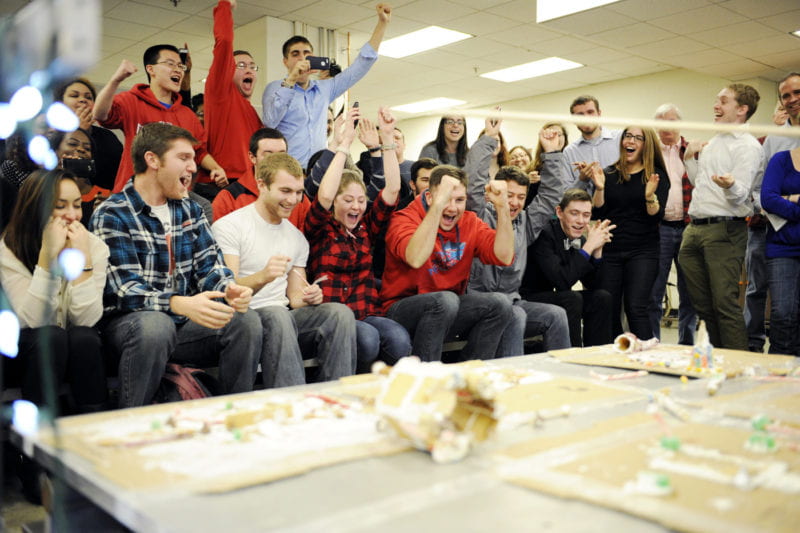The stage was set on Wednesday for the Northeastern student chapter of the American Society of Civil Engineers’ annual gingerbread house competition. And then that stage shook, and shook, and shook until none of the gingerbread houses were standing. This friendly competition, which is held each December in the Snell Engineering Center’s seismic lab, challenges teams of engineering students to construct gingerbread houses that can withstand the lab’s earthquake simulator.

Teams put the finishing touches on their gingerbread houses before putting them on the earthquake simulator. Photo by Matthew Modoono
As the simulator shook harder and harder, and the gingerbread houses teetered on their foundation, the cheers from the crowd of more than 50 people grew louder as they waited for the first structure that would topple. To start, each of the five teams received a gingerbread house starter kit from ASCE including graham crackers, candy canes, and icing, which they subsequently used to build a two-story structure. Additional edible material such as candy canes and pretzels was also provided, which ASCE’s secretary Corinne Bowers, E’18, said is used to either reinforce the structures’ stability or improve their aesthetics.
The houses earned points in a variety of categories including how it performed on the skate-table, creative design, and how many likes photos of each house received on the NU ASCE Facebook page. Team Mishac’s Minions decided to forgo the building of a stylistic gingerbread house and did not put a roof on its structure. “We knew (our gingerbread house) was going to be ugly,” said Kristy Bell E’15. “We wanted it to have a heavier base and be lighter at the top.” The theme of this year’s competition was natural disaster. In addition to the earthquake simulation, the gingerbread houses were tested against high winds generated by a fan. They were also sprayed with water before the competition to mimic a hurricane. It was ultimately the H20 that team C^2 said led to its structure’s failure in the earthquake simulation, with the water loosening the icing foundation. “We are happy it stayed in one piece even though it lifted off the table,” said Christine Lai, E’16. The gingerbread houses that managed to survive the water, wind, and earthquake were then put through the rigors of the final test from Distinguished Professor of Engineering Mishac Yegian, who saw to it that none of the houses were left standing by the end of the competition by cranking up the shake-table levels so every single house fell off.
“I’m going to break every one of them,” said Yegian, who runs the seismic lab. “I have to get them off the table or I am not happy.”
